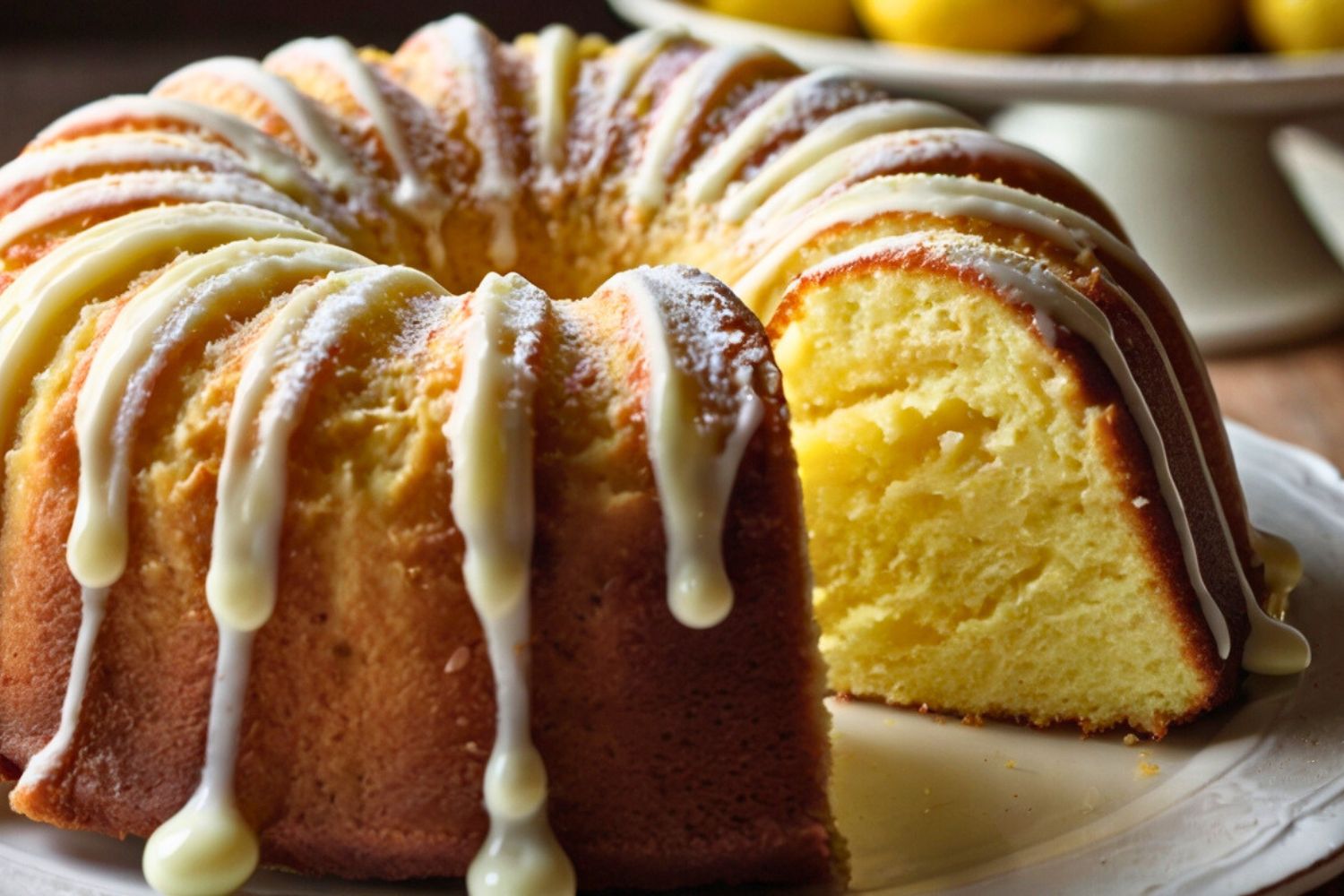Have you ever tasted sunshine in cake form? That’s exactly what you get with this Italian Lemon Pound Cake Recipe. Bright, zesty, and rich, it feels like home and celebration in every bite. I still remember tasting it at a friend’s Italian grandmother’s table. One slice, and I was hooked. The lemony aroma, tender crumb, and delicate glaze? Pure magic.
Now, I want you to enjoy that same magic at home. In this post, I’ll guide you step by step to master this Italian Lemon Pound Cake Recipe. You’ll get that golden crust, a soft lemony center, and just the right balance of tart and sweet.
What makes this Italian Lemon Pound Cake Recipe special? It’s simple, honest baking. No tricks just fresh ingredients, a hint of lemon love, and easy steps. By the end, you’ll bake a cake to proudly share or sneak slices when no one’s looking. This Italian Lemon Pound Cake Recipe is one you’ll come back to again and again
What Makes This Cake So Special?
Here’s the thing about Italian baking, they don’t mess around with mediocre ingredients or shortcuts. Every element has a purpose, and when you combine them just right, magic happens.
This cake gets its incredible texture from a technique called “creaming” that most people rush through. But we’re not gonna do that. We’ll take our time and do it right, separating good cakes from unforgettable ones.
The Italian twist comes from using both lemon zest and juice, plus that hint of limoncello that adds this subtle complexity. It’s not boozy, it just deepens the lemon flavor in a way that makes people go “wow, what is that?”
Ingredients & Smart Swaps

For the Cake:
- 1 cup (2 sticks) unsalted butter, room temperature
- 1¾ cups granulated sugar
- 4 large eggs, room temperature
- 3 cups all purpose flour
- 1 teaspoon baking powder
- ½ teaspoon salt
- 1 cup whole milk, room temperature
- Zest of 4 large lemons (about 3 tablespoons)
- ¼ cup fresh lemon juice
- 2 tablespoons limoncello
- 1 teaspoon vanilla extract
For the Lemon Glaze:
- 1½ cups powdered sugar
- 3-4 tablespoons fresh lemon juice
- 1 tablespoon lemon zest
Now, let’s talk swaps because life happens, and we work with what we’ve got.
Butter: You can substitute with vegetable oil, but use ¾ cup instead of a full cup. The texture will be slightly different, still delicious, but not quite as rich.
Limoncello: Don’t have any? No problem. Use an extra tablespoon of lemon juice mixed with a teaspoon of vanilla. Or if you’ve got some vodka hanging around, mix 2 tablespoons vodka with 1 teaspoon lemon extract.
Whole milk: Buttermilk works beautifully here and actually adds a lovely tang. You can also use 2% milk, just don’t go lower than that or your cake might turn out a bit dry.
Fresh lemons: Here I’ll be stubborn. Please don’t use bottled lemon juice. Fresh lemons contain oils in their zest that create flavor compounds bottles can’t match.
Here’s an insider tip about picking lemons: the heavier ones have more juice. Give them a gentle squeeze, they should have a little give but still feel firm. And if you can smell that lemony fragrance even through the skin, you’ve found yourself some good ones.
Step by Step Magic
Step 1: Get Everything Ready
Preheat your oven to 325°F. Yes, 325°F, not 350°F. This lower temperature is crucial for getting that perfect, even crumb.
Grease a 10-inch bundt pan with butter, then dust it with flour. Don’t skip this step, there’s nothing more heartbreaking than a gorgeous cake that sticks to the pan.
Step 2: The Creaming Process
In a large bowl, beat that butter until it’s light and fluffy. This takes about 3-4 minutes with an electric mixer. Don’t rush this part, this is where we’re building the cake’s structure.
Gradually add the sugar, beating for another 2-3 minutes. The mixture should look almost white and feel smooth when you rub it between your fingers.
Step 3: Add the Eggs
Add eggs one at a time, beating well after each addition. Here’s where things can go wrong if you’re not careful. If your eggs are cold, they might cause the mixture to curdle. Room temperature eggs blend in like a dream.
Step 4: The Dry Ingredients
In a separate bowl, whisk together flour, baking powder, and salt. This isn’t just busy work, it ensures everything gets distributed evenly.
Step 5: Bringing It All Together
Now we alternate. Add about a third of the flour mixture to the butter mixture, mixing just until combined. Then add half the milk, mix gently, another third of flour, the rest of the milk, and finally the remaining flour.
Here’s the golden rule: stop mixing as soon as you don’t see flour streaks anymore. Overmixing develops gluten and makes your cake tough. We want tender, not chewy.
Step 6: The Lemon Magic
Fold in the lemon zest, lemon juice, limoncello, and vanilla. This is where your kitchen starts smelling like heaven.
Step 7: Into the Oven
Pour the batter into your prepared pan and smooth the top. Bake for 60-70 minutes, until a toothpick inserted in the center comes out with just a few moist crumbs.
Don’t open that oven door for at least 50 minutes. I know it’s tempting, but temperature fluctuations can cause your cake to sink in the middle.
Step 8: The Cooling Game
Let the cake cool in the pan for 15 minutes, then turn it out onto a wire rack. This timing is important, too soon and it might break apart, too late and it might stick.
The Science Behind the Sizzle of Italian Lemon Pound Cake

Let’s talk about why this recipe works so well. When we cream butter and sugar together, we’re creating thousands of tiny air pockets. Those pockets expand in the oven heat, giving us that light, tender crumb.
The lower oven temperature is key here. At 325°F, the cake bakes slowly and evenly, preventing a tough crust from forming before the inside is done. It’s like the difference between a slow braise and a quick sear – both have their place, but for pound cake, slow and steady wins.
The combination of lemon zest and juice does something really special. The zest contains oils that provide intense lemon flavor without adding liquid. The juice adds brightness and acidity that balances the richness of all that butter.
That splash of limoncello? It’s not just for show. Alcohol actually carries flavor compounds that water-based ingredients can’t, which is why it makes the lemon taste more lemony. Most alcohol bakes off, leaving pure flavor behind.
Making It Beautiful & Delicious
Once your cake is completely cool, it’s time for the glaze. Whisk together powdered sugar, lemon juice, and zest until smooth. Start with 3 tablespoons of lemon juice and add more if needed – you want it thick enough to coat the cake but thin enough to drizzle.
Pour that glaze over the cake, letting it drip down the sides. Some of it will pool at the bottom, and that’s perfect. Those little puddles of glaze are like flavor bombs.
For serving, this cake is gorgeous on its own, but it plays beautifully with fresh berries, especially strawberries or blueberries. A dollop of lightly sweetened whipped cream doesn’t hurt either.
If you’re serving this for a special occasion, try pairing it with a glass of Prosecco or a light Pinot Grigio. The bubbles and acidity complement the lemon beautifully.
Storage and Make-Ahead Tips
This cake actually gets better after a day or two. The flavors meld together, and the texture becomes even more tender. Store it covered at room temperature for up to 4 days, or freeze it (without the glaze) for up to 3 months.
If you’re making it ahead, you can bake the cake and freeze it, then thaw and glaze it the day you’re serving. Or make the whole thing and keep it in the fridge – just bring it to room temperature before serving.
Variations to Try
Once you’ve mastered the basic recipe, here are some ways to make it your own:
Orange Pound Cake: Substitute orange zest and juice for the lemon, and use Grand Marnier instead of limoncello.
Almond Lemon: Add ½ teaspoon almond extract to the batter and sprinkle sliced almonds on top of the glaze.
Lavender Lemon: Mix 1 teaspoon dried culinary lavender with the flour. It sounds fancy, but it’s absolutely divine.
The Perfect Italian Lemon Pound Cake
What makes this recipe worth your time is that it delivers something really special, a cake that tastes like it came from an Italian bakery, but it’s totally doable in your own kitchen. The technique isn’t complicated, but the results are impressive enough to make people think you’re some kind of baking wizard.
The key is taking your time with each step and not rushing the process. Good baking is like good conversation – it can’t be hurried, but when you do it right, it’s absolutely worth the wait.
Italian Lemon Pound Cake: Questions & Answers
Can I make this cake without limoncello?
Answer: Absolutely! While limoncello adds lovely depth, substitute with extra lemon juice and vanilla extract. The cake stays delicious with slightly different flavor.
Why did my cake turn out dense instead of light and fluffy?
Answer: This usually happens from overmixing batter after adding flour, or using cold ingredients. Keep eggs, butter, and milk at room temperature. Mix just until flour disappears.
Can I use a different pan if I don’t have a bundt pan?
Answer: Sure! Use two 9-inch round pans or 9×13 inch rectangular pan. Adjust baking time check doneness around 35–40 minutes for rounds, 45–50 minutes for rectangular.
My glaze is too thick/thin. How do I fix it?
Answer: Too thick? Add lemon juice one teaspoon at a time. Too thin? Add powdered sugar gradually. Perfect glaze coats spoon backs but drizzles easily.
Can I make this cake dairy-free?
Answer: Yes! Use plant-based butter substitute and non-dairy milk. Texture changes slightly but stays delicious. Keep all substitutes at room temperature before mixing.

Swiftly Captions by Tina Smith — Quick, flavorful food recipes made simple, bringing fresh inspiration to your kitchen every day






